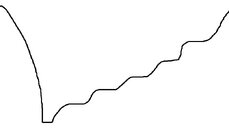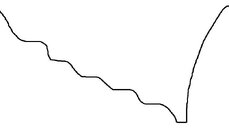The OP's question makes sense when you consider he only has 25-50 dives. Most classes are taught with tables and the usefulness of some computer functions are not immediately obvious. It makes sense for a new diver to assume that tables use max depth because that is the only number you have (which is true) and it is not out of the realm of possibility for a new diver to wonder if the average depth offerred by a computer might work better. I think SDI teaches based on computers, but computer A is different than computer B so some learnig still occurs later.
Either way, I'd cut the OP some slack on asking the question and not go with the the mostly unhelpful "you'll learn that in class" or "you need to review it" responses.
Average depth is very useful for figuring the SAC rate/RMV for the dive.
1. Determine the cu ft of air used. For example if you started with 3000 psi in an AL80 and ended with 1200 psi.
77 cu ft / 3000 psi = .02567 cu ft/psi
.02567 X 1800 = 46.2 cu ft.
2. divide the gas used by the dive time. For example assume the dive time was 33 minutes.
46.2/33= 1.4 cu ft/minute
3. Convert the average depth to atmoshperes. For example your average depth was 57 feet.
(57/33) + 1 = 2.73 ATM
4. divide the cu ft used per minute at the average depth by the atmospheres of the average depth to determine your surface consumption rate.
1.4 / 2.73 = .513 cu ft per minute.
On your next dive under similar conditions you can use this to estimate the gas you will use at a different depth.
For example, If I am diving to 105':
1. figure out the ATM's at 105'
(105/33) +1 = 4.18
2. Take your SAC of .51 and multiply it times the ATM
.51 X 4.18 = 2.13 cu ft / minute
3. Figure your available gas minus the reserve
1/3 in reserve (1000 psi reserve) in an AL 80, (77/3) X 2 = 51 cu ft
4. divide the available bottom gas by the depth use rate of 2.13 cu ft/ minute
51/2.13 = 23.94 minutes maximum bottom time.
NOTE: The minutes available from a gas planning standpoint may exceed your NDL at a given depth with a given RNT and a given mix.
NOTE #2: Your gas consumption may vary and be higher or lower than planned due to workload, current, water temp, moon phase, etc.
It has its limitations and cautionary notes, but over time you will develop a pretty good feel for your SAC rate under various conditions and you will find it will help give you some firmer numbers for gas planning purposes.
In the good old days we had SAC rate computers that were special purpose circular slide rules. (they show up on e-bay now and then). SAC rate is by definition based on psi and is tank dependent while RMV is based on volume in cu ft or liters and is not tank dependent, but the terms are now more or less interchanged regardless of the psi or volume format used.
With a SAC rate computer, you just find the average depth and align it with the psi used on the outer wheel and turn the inner wheel to 33 minutes and then read the SAC rate in PSI in the window - 20 psi per minute in this case.
You could then either convert it to cu ft:
77 cu ft/3000 psi = .0257, .0257 X 20 = .514 cu ft/ min
Or if you use the same size tank, you could just figure every thing in psi by setting the depth, time and SAC on the SAC computer and read the psi used.
Set what ever you think may be appropriate for a bottom time for the bottom time, 20 psi/minute in the SAC window and then read the psi used across from any given depth. Adjust the time up or down to get more or less reserve left at the end of the dive.






